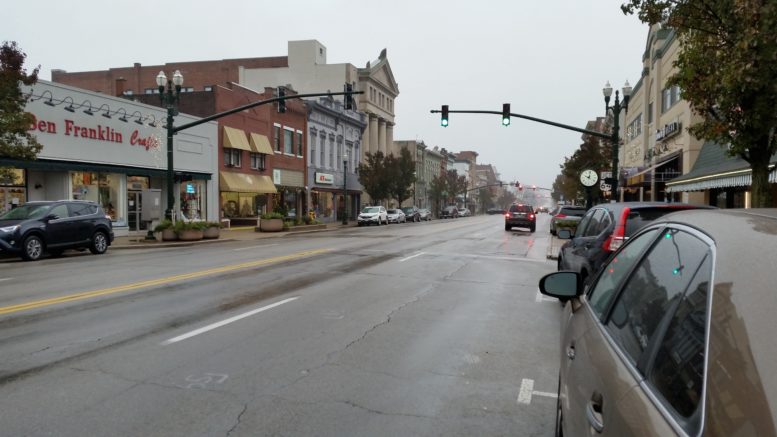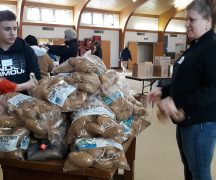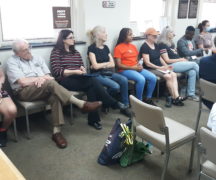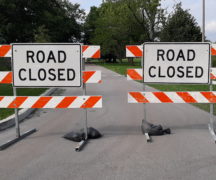By JAN LARSON McLAUGHLIN
BG Independent News
Nearly 1,000 Bowling Green residents piped up with ideas when the city asked for suggestions on how it should spend the remaining $3 million in COVID relief funds.
Residents not only ranked the projects listed in the questionnaire, but they also tossed in more than 900 ideas of their own.
“The majority of them are very constructive,” said Hallie Williams, city community affairs coordinator. “There are a few negative ones.”
City officials were pleasantly surprised that 969 residents submitted their suggestions to the questionnaire, said Sustainability and Public Outreach Coordinator Amanda Gamby.
“I’m really impressed. We got some really good feedback,” Gamby said.
Residents seem to realize that this American Relief Plan Act funding should be used carefully.
“It’s once in a lifetime to have this infusion of funds,” Williams said. “They genuinely care about their community.”
The results of the questionnaire will be considered along with the input from residents at a public forum on how to use the remaining $3 million. That meeting will be held May 12, at 6 p.m., in council chambers.
“We want to meet the community’s needs,” Gamby said. So City Council is giving residents a chance to voice their ideas in person. “I think it’s pretty cool.”
The questionnaires offered four primary areas for community investment: Parks and recreation, community development, pedestrian and bike safety, and the downtown. In each category, residents were asked to rank five projects. Following are the results of those rankings, listed in order of the highest to lowest scoring:
Parks and recreation
- Shade structures at City Park and Community Center athletic fields.
- Roof replacement for the Community Center.
- Paving trails at Simpson Garden Park.
- Outdoor pickleball courts.
- Repave Carter Park parking lot.
Community development
- Small business grants.
- Plant trees within rights-of-way.
- Murals/public art.
- Electric vehicle charging stations.
- Oak Grove Cemetery capital improvements.
Pedestrian and bike safety
- Repair existing sidewalks.
- Construct new sidewalks.
- Separated bike paths.
- Multi-use path from BG High School/Middle School to Community Center and Cogans Crossing.
- On-street bicycle treatments (sharrows, bike lanes, etc.)
Downtown BG
- Downtown public restrooms.
- Downtown building facade improvements.
- Alleyway improvements.
- Downtown right-of-way redesign to widen sidewalks.
- Downtown dumpster enclosures.
Bowling Green received $7.3 million last year in ARPA funds designed to help communities recover from the economic impacts of the COVID pandemic.
So far, the city has approved using the funds for:
- $3 million for residential street paving.
- $350,000 for MARCS radios to improve public safety communications.
- $250,000 for paving at City Park, including road widening, a walking path, and security improvements.
- $100,000 for inclusive playground at Carter Park.
- $300,000 for housing grants over three years.
That leaves about $3 million that the city can spend – and city officials want input from the community.
Those presenting at the May 12 forum are asked to select a spokesperson if part of a larger group, and to keep presentations to seven minutes or less. No decisions on the ARPA funds will be made at the May 12 forum.
Under U.S. Department of the Treasury guidance, ARPA funding may replace city revenue lost during the pandemic. As such, there is great flexibility in the projects that may be funded.
All of the 900-plus additional ideas submitted on the questionnaire have also been given to City Council members for review.
Some of the suggestions for the downtown included more outdoor seating for restaurants, drinking fountains, an outdoor piano, a graffiti alley to showcase street art, and rerouting of semi-truck traffic around downtown.
Many people mentioned bike infrastructure – with some wanting the ultimate accommodation of bike lanes or bike paths. One person said bike lanes are greatly preferred over sharrows, which are basically “thoughts and prayers” for bike safety.
Several residents spoke in favor of mixed used paths – from Crim Elementary to Carter Park, connecting City Park to the Slippery Elm Trail, from the Bird Streets to the Community Center.
On the suggestion of using ARPA funds for housing grants, several people stressed that those funds should not go to landlords, but instead to lower-income homeowners. It was suggested that grants be established for families who purchase single-family homes to help reverse the trend of “apartmentalization.”
Some voiced support for increased public transportation, with one casting a vote for bringing back the trolley on Wooster and Main streets.
Parking downtown seemed to be a hot button issue. Many wanted more, with some suggesting a parking structure for customers, employees and residents in the downtown area.
Others felt the city has already spent a lot to improve the downtown – which is unfair to other business owners. It was suggested the city invest in all corners of the community.
Many favored grants for small businesses that struggled through the pandemic. Others suggested the city do something with the empty storefronts at Wooster and Manville.
Several comments were critical about the “eyesore” mall, and of the “deplorable” smell around Poe Ditch. “I would love it if travelers coming from the expressway didn’t have to smell our town before they get to experience it,” one person wrote.
Many residents asked for dog parks, outdoor pickleball courts, community tennis courts, and Carter Park disc golf course improvements. Others wanted a snow machine at the Conneaut sledding hill, a free public sprinkle system for kids to play in, and an indoor pool at the community center.
A few asked that the city allow the country club golf course lease to expire, so the land could be used by the community. People suggested an outdoor sand volleyball court, an exercise station system in City Park, and a place to kayak or fish.
Traffic issues were noted by many people, including those who requested a traffic light at the corner of Haskins and Wooster streets, more crosswalks on Main Street, roundabouts where South College intersects with Napoleon and with Wooster, and a crosswalk near Williams and East Wooster.
Other suggestions included:
- More community involvement such as block parties or neighborhood gatherings.
- More chain restaurants and businesses.
- More places for kids to have fun.
- Something to make younger generations want to stay here.
- Community gardens.
- More trees.
- Picnic tables, chairs and firepit in Wooster Green.
- Solutions to neighborhood flooding issues.
- Sidewalks added in neighborhoods that have none, and repaired where they are a hazard.
- Year-round farmers market.
- Homeless and rental assistance.
- A new fire station or two.
- Curbside compost pickup.
- Leaf collection system with vacuum that won’t tear up lawns.
- Pay residents’ trash fees for a year.
- More electric vehicle charging stations.
- Raises for city employees.
- Help the school district with building expenses.
- Decriminalize marijuana.
“Surprisingly nobody asked for an Applebee’s,” Williams joked. “I was expecting at least one.”





